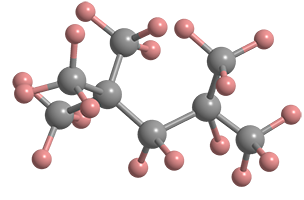What molecule am I?


Isooctane, formally, 2,2,4-trimethylpentane, is a branched-chain hydrocarbon. It first appeared in the chemical literature in 1898, when Francis E. Francis and Sydney Young* at University College, Bristol (UK; now the University of Bristol) treated branched paraffins with fuming nitric acid to produce nitroalkanes.
Isooctane is best known as the high point (100) on the octane number scale for rating the antiknock properties of gasolines. (n-Heptane1 is the low point at zero.) In a 1928 study, John M. Campbell, Wheeler G. Lovell, and T. A. Boyd at General Motors (Detroit) used isooctane, n-heptane,, benzene, and the antiknock compound tetraethyllead2 as gasoline additives in varying concentrations to demonstrate the importance of mixture ratios on the tendency of fuels to knock. The authors stressed the importance for laboratories to use standard ratios for knock testing to ensure reproducible results and to obtain comparable results between labs.
Research on gasoline performance using isooctane as a model antiknock compound continues to this day. In an example from this past February, Xu He at the Beijing Institute of Technology and the Collaborative Innovation Center of Electric Vehicles in Beijing and coauthors there and at Tsinghua University (Beijing) showed that adding ammonia to isooctane increased hydrogen abstraction and lowered knocking.
Isooctane is manufactured via the acid alkylation of isobutylene with isobutane or via isobutylene dimerization followed by hydrogenation. It has additional uses as a solvent and a paint thinner. For more information about isooctane, see the ScienceDirect information page.
1. CAS Reg. No. 142-82-5.
2. CAS Reg. No. 78-00-2. Tetraethyllead was phased out as a gasoline additive in the United States almost 50 years ago.
Isooctane hazard information
| Hazard class* | GHS code and hazard statement | |
|---|---|---|
| Flammable liquids, category 2 | H225—Highly flammable liquid and vapor | |
| Aspiration hazard, category 1 | H304—May be fatal if swallowed and enters airways | |
| Skin corrosion/irritation, category 2 | H315—Causes skin irritation | |
| Specific target organ toxicity, single exposure, narcotic effects, category 3 | H336—May cause drowsiness or dizziness | |
| Short-term (acute) aquatic hazard, category 1 | H400—Very toxic to aquatic life | |
| Long-term (chronic) aquatic hazard, category 1 | H410—Very toxic to aquatic life with long-lasting effects | |
*Globally Harmonized System (GHS) of Classification and Labeling of Chemicals. Explanation of pictograms.
Molecules from the Journals
According to Michael E. Ziebel, Xavier Roy, and co-workers at Columbia University (New York), “The discovery of magnetic order at the 2-D limit has sparked new exploration of van der Waals magnets for potential use in spintronics, magnonics, and quantum information applications.” Many such materials, however, have undesirable properties, such as instability in air, and cannot be used in practical devices.
But last month, Ziebel et al. described chromium sulfide bromide1 (CrSBr) as a promising air-stable, 2-D magnetic semiconductor. In a mini-review, they discussed experimental findings on bulk CrSBr, including quasi-1-D semiconducting properties, A-type antiferromagnetic order, and strong coupling between its electronic and magnetic properties.
Catharanthine2 is an iboga-type indole alkaloid that was isolated from the flowering plant pink periwinkle (Catharanthus roseus) in 1959 by Marvin Gorman, Gordon H. Svoboda, and co-workers at Lilly Research Laboratories (Indianapolis). Former Molecule of the Week ibogaine3 and other iboga-type alkaloids are known to reduce opioid, ethanol, and nicotine withdrawal symptoms; but serious side effects prevented them from attaining clinical use.
Catharanthine had not been evaluated for this use until Scott C. Steffensen at Brigham Young University (Provo, UT) and 13 collaborators there and at other institutions in Utah, Oklahoma, and South Korea reported in April that the compound “has potential as a therapeutic treatment for nicotine addiction” by “modulat[ing] mesolimbic dopamine transmission and nicotine psychomotor effects via inhibition of α6-nicotinic receptors and dopamine transporters” in mouse studies. It is expected to avoid the serious side effects associated with ibogaine based on studies on the similar molecule 18-methoxycoronaridine4.
1. CAS Reg. No. 16789-23-4.
2. CAS Reg. No. 2468-21-5.
3. CAS Reg. No. 83-74-9.
4. CAS Reg. No. 308123-60-6.
Molecules from the Journals
MOTW briefly describes noteworthy molecules that appeared in recent ACS journal articles. See this week's
edition below.
Isooctane fast facts
| CAS Reg. No. | 540-84-1 |
| SciFindern name | Pentane, 2,2,4-trimethyl- |
| Empirical formula | C8H18 |
| Molar mass | 114.23 g/mol |
| Appearance | Colorless liquid |
| Boiling point | 99.2 °C |
| Water solubility | 0.6 mg/L (20 °C) |

Learn more about this molecule from CAS, the most authoritative and comprehensive source for chemical information.
Molecule of the Week needs your suggestions!
If your favorite molecule is not in our archive, please send us a message. The molecule can be notable for its current or historical importance or for any quirky reason. Thank you!
Stay Ahead of the Chemistry Curve
Learn how ACS can help you stay ahead in the world of chemistry.

